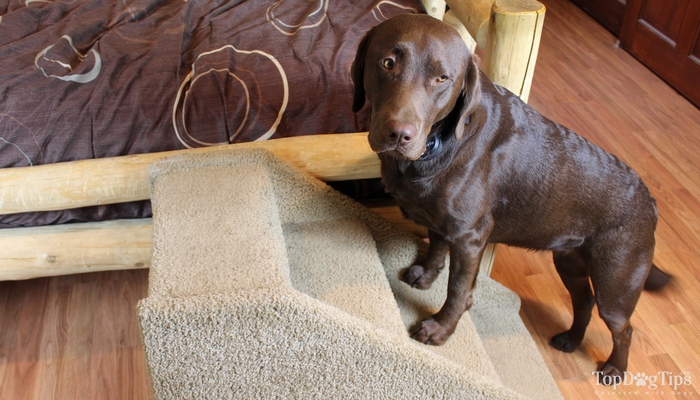
Table of Contents
So you're in the market for either pet stairs, steps, or ramps.
You have a reason to buy one but aren't sure which option fits your dog or your home better.
You're not alone because most dog owners are often confused about the differences between dog ramps, dog stairs, and dog steps.
In this article, you will know the difference between dog ramps vs dog stairs and dog steps.
This guide will help you decide which is the best option for your pooch.
Dog Ramps vs Dog Stairs: Why Do We Need Them?
There are several reasons a pet owner usually needs a pet ramp or stairs:
- Senior and/or arthritic dogs that need assistance
- Dogs with other hip and joint problems
- To prevent unnecessary stress on dog's joints and hips
- Small breeds or puppies that need help getting into cars or onto the bed
 Regarding joint problems in dogs, dog stairs, steps, or ramps are always a good idea.
Regarding joint problems in dogs, dog stairs, steps, or ramps are always a good idea.
Several studies have found that jumping or even climbing steep surfaces places a lot of stress on the dog's joints because they're not designed to sustain it (unlike humans).
Further, research also found that climbs and jumps increase the likelihood of arthritis.
Dogs who are more active and spend a lot of time jumping up and down from elevated surfaces are much more likely to experience joint pain, agility issues, or develop arthritis later in their lives.
How Both Benefits Dog Owners
On a different note, using dog ramps or steps can also help us dog owners.
The most common example is pet owners with SUVs and medium-sized dogs.
If your dog cannot get into the back of your car, it means you have to pick him up and help him into the vehicle. Doing so regularly places a lot of unnecessary stress on your back and joints.
The same goes when you're picking up your small dogs and putting them in bed. This requires extra stretch and strength, especially if you have plump pooches.
Samantha has done a wonderful video explaining how to help a dog into the vehicle, why dog ramps are helpful for everybody, and how to avoid hurting yourself and your dog.
With that said, how does a pet owner decide between dog ramps or steps/stairs?
READ ALSO: Tricks for Training a Dog to Use Pet Steps, Stairs, and Ramps
Dog Steps and Dog Stairs: Everything You Need to Know
Every pet and situation is different; therefore, there is no basic and simple solution for selecting pet steps, stairs, or a pet ramp.
With so many options of dog steps and stairs available, you'll need to consider several factors, which I will list for you below.
Dog Steps and Dog Stairs: What's the Difference?
Pet stairs are the most commonly chosen option for dogs familiar with and physically capable of handling “people” stairs.
But if your pup has never climbed a set of stairs and has a tough time understanding how to use them (it's much more common than you think), then you should either spend time teaching your dog how to use stairs – which is highly recommended – or opt for a dog ramp instead.
A common question: what's the difference between dog steps and dog stairs? Essentially, there is no difference.
The two are used interchangeably when it comes time to shop for a set of pet stairs or steps, and we'll refer to both throughout this article.
Most pet stairs/steps for dogs look something like these from Pet Gear:
There are two different designs of pet stairs, one of them being more mobile and easy to move but not as sturdy.
The more mobile type of pet stairs for dogs will resemble a ladder-like Solvit.
Dog Steps or Stairs: Choosing the Right Type
Dog stairs come in several different sizes and heights to fit every breed (the overall height and the height of each step) and several steps (usually from 2 to 4).
Picking the right size is key. You must know what size of dog stairs will be the best fit for your pet, or you could end up making it physically harder on your Fido to climb those stairs than it would be simply to jump up into the car or onto a bed.
Do your research to find out the exact measurement of pet stairs you're about to purchase.
Measure your dog accurately and then measure all the furniture, vehicles, and other heightened surfaces where you believe your Fido will be using those pet stairs.
If you need help measuring your dog for a perfect set of stairs (or a ramp) and how to pick the right type, watch this quick video guide from Samantha.
Five Key Components in Choosing Dog Stairs
- Overall height of dog steps
- Depth of steps
- Width of steps
- Materials used
- Bottom grip
It is essential to note the rise or height of each step. For example, regular outdoor or indoor pet stairs have individual step rises that measure approximately 6.5 to 7.5 inches in height.
Therefore, the dog steps you choose should be of a similar size.
Another thing to consider is the depth of each step. Your dog will prefer deep and roomy steps because they make it easy for him to climb and maneuver while walking up or down (and some dogs fear narrow steps).
A good rule of thumb is to ensure that each step has a depth of 10 to 12 inches for the easiest usage.
You also want to be conscious of the material your pet steps are made of.
If you have a lightweight, small breed dog, foam stairs may be a good option for him.
Foam steps are also good for small and medium arthritic dogs or those with joint pain.
Important: Always make sure to check the weight limit of any pet stairs for your dog before you purchase them.
However, if your large breed dog weighs over 100 pounds, foam steps certainly won't do the trick because they won't handle the weight, nor will they inspire confidence in your dog.
This is when you go after dog stairs made from plastic, wood, or metal.
After doing some research, I found that the most common reason many dog steps and stairs are returned on Amazon is that the owners didn't read the description on the product page about their measurements and/or didn't measure their dog (correctly).
RANKED: Top 10 Best Dog Steps for Beds and Cars
Pros of Dog Steps or Dog Stairs Over Dog Ramps
One of the major advantages dog steps and stairs have over pet ramps is that they often take up less space when used, while both are designed for pets to reach the same height.
The way dog ramps are designed, they are not very ergonomic when extended, nor can they be (however, some dog ramps are easier to store than pet steps).
Pet steps can be placed alongside a bed or chair and are ideal for tight or limited spaces.
If your dog is young or middle-aged and in good health, steps offer a great way to move up and down safely from a variety of furnishings in almost any area of a house or apartment without taking up as much space as dog ramps do.
You can also use dog stairs outside your home, as you can use them next to decks, vehicles, or doors.
While most pet owners can find the right size and type of pet stairs for their dog, some may like to have a special size. In that case, some companies are willing to customize a set of pet stairs according to your specifications.
Call the manufacturer to obtain a quote and compare it with other dealers who offer customization.
Here are a few pet companies that offer customized pet stairs for dogs:
Finally, high-quality dog stairs are almost always cheaper than high-quality dog ramps due to cheaper quality builds and less material used, so they're perfect for owners on a budget.
There are indeed dog ramps that are priced the same as pet stairs, but I would never trust any of those (if you've seen them live, you know what I mean).
Cons of Dog Steps or Dog Stairs Over Dog Ramps
As for disadvantages when comparing pet stairs and steps to dog ramps, there are a few of those as well, both of which can be a deal-breaker for some dog owners.
In fact, there are three significant differences between dog steps and stairs.
First, when everything is set up, locked, and secured, most dog steps are less reliable and sturdy than dog ramps.
If you secure your dog ramp properly, it will always be much sturdier and immovable than a set of dog stairs.
Second, dog ramps are always better for arthritic dogs than pet stairs.
Even though pet stairs are better for your dog than simply jumping up and down from elevated surfaces, they still require some effort and stress on the dog's joints.
On the other hand, dog ramps allow your Fido to walk the ramp with significantly less stress placed on the joints.
Finally, some dogs prefer ramps over steps because they don't seem to trust a small, iffy, narrow-looking set of pet stairs (and I can certainly understand them).
Dog ramps look much more acceptable; however, this isn't the case with every dog, and some actually avoid both ramps and steps no matter what.
RELATED: How Dog Stairs Can Help a Dog With Arthritis
For more tips, you can watch our reviews of many different pet stairs and pay attention to what we look for when picking the best dog steps, what cons and pros we've noticed with these products, and what makes a good set of pet stairs.
Here is one of the reviews.
Dog Ramps: Everything You Must Know
We've already discussed the many advantages and disadvantages when comparing pet steps and dog ramps, which should give you a good idea of what you might want.
Here are just a few more things you'll also be glad to know about dog ramps.
Here is what a big dog ramp from Pet Gear looks like:
While there are many options of pet ramps for dogs to choose from, the major mistake many owners of senior dogs make is they forget to, first of all, consider their old dog's current health condition and any agility issues.
Note: Getting your older pet acclimated to using a dog ramp is necessary before he is beset with further visual or muscular difficulties.
For example, if your Fido is elderly (11 years or older), climbing any pet stairs of any size is likely physically uncomfortable at this point in his life.
Owners with senior dogs may want to stop considering dog steps regardless of the lower price tag and direct their sights toward a pet ramp for dogs to prevent further health complications.
Many pet owners agree that a dog ramp is the easiest and the most humane solution for pets that have become arthritic or disabled with age.
Pet ramps are also advocated for dogs in single-floor homes who have never liked or mastered using the stairs.
Dog ramps should also be considered for canines recovering from injuries who would benefit from the straight walk-up instead of lifting their legs over stairs.
How Tall the Dog Ramp Should Be
Special consideration needs to be made when selecting a proper ramp length.
Obviously, the higher the reach, the longer the dog ramp is required to be. As a result, the length of the ramp directly impacts how steep the slope or incline will be for your dog.
Ramps are designed for indoor and outdoor use (some are made for both).
Before shopping for one, you'll need to determine when and where they will use the ramp.
Most pet owners prefer to use a dog ramp for beds, but choosing one will depend on their height and design. This is one of the factors to consider when choosing a dog ramp indoors.
Quick tip: Whether you're buying dog steps or a dog ramp, purchase a model with carpeting or some type of gripping material so your dog won't slip and fall.
Different Slopes of a Dog Ramp
A pet ramp is usually considered tall if it is more than two feet high, while low ramps are generally about 1.5 feet high or lower.
The wider the ramp, the easier it will be for your dog to balance and maneuver while climbing on it.
Typical ramp widths are between 1 and 1.5 feet. Likewise, an easy slope is generally 18 degrees, while a normal or medium slope rests at about 22 degrees.
Climber slopes are generally 26-degree inclines and aren't used very often. Owners with miniature dog breeds should prioritize dog ramps over dog steps.
The reason is that these smaller breed dogs are too short for indoor pet steps, and it would be considered a safety hazard if the dog needs to jump up or climb to get to the next stair.
Essentially, it negates the whole purpose of pet stairs. Even a tumble from a height of 6 inches may cause a bad injury for these fragile little pups.
Factors To Consider Before Buying a Dog Ramp
In general, there are five features you need to look out for when purchasing the best dog ramp not only for your pet but also for yourself and your home:
1. It can be stored easily, anywhere.
You want a ramp that won't take up much space at home or in a car when not used.
Usually, most ramps will be folding (or telescopic models), but remember to confirm if that's the case. You don't want to be stuck with a giant dog ramp that you cannot fold.
2. It's lightweight and small enough.
Another important aspect of a good ramp for dogs is how easily you can handle it.
Ideally, you want something light and small enough to put it together quickly whenever you need to.
Ramps don't have to be miniature, but the smaller you can get, the easier it will be for you.
3. Its sturdiness and reliability.
Even though you want a lightweight ramp, sturdiness and strength should also be there; it's no less important for you to have confidence in the product.
You can judge good ramps for pets by looking at their weight capacity. Buy the one according to your pet's weight and triple-check that.
4. It has a perfect surface.
Many pet owners forget about the importance of grip when it comes to ramps.
For those of you who plan to use a ramp outdoors (and if you're using it with a vehicle, then that's most likely the case).
Ensure a good surface where your dog won't slip when the ramp is wet.
5. Any safety precautions.
Last but definitely not least is how safe your dog ramp will be.
Front and rear stabilizers on-ramps are the first things you must check ten times before using the product actively. There are also non-skid feet that will ensure the stability of the ramp.
For even more safety precautions, you can choose ramps with side railings that stabilize the ramp and prevent falls.
When it comes to safety among stairs, pet owners would choose a dog ramp for stairs rather than having dog steps that would still have the same impact as regular human stairs.
To better understand what I'm talking about, I recommend you casually peruse some of the dog ramp best sellers on Amazon and read the product descriptions and other pet owners' reviews.
Don't rush into buying anything but rather gather the information.
RANKED: Top 5 Best Dog Safety Ramps
The featured image courtesy of Animal Planet was originally published on their Amazon product page.
Disclosure: We may earn affiliate commissions at no cost to you from the links on this page. This did not affect our assessment of products. Read more here and find full disclosure here.
Common Questions about Dog Stairs vs Dog Ramps
If you still have questions about finding the best dog stairs for your pup, the following FAQ should answer them.
What Are the Best Dog Stairs?
The best stairs will be the ones that make climbing stairs easy for your dog. You want something sturdy and comfortable on your dog's paws.
Any of the products mentioned above are great choices. It will also depend on your preferences, including how much space you have.
Are Dog Stairs or Ramps Better?
If your dog is healthy and not a senior dog with ailing joints, either ramps or stairs can be a great choice.
There is no need to debate between ramps vs. dog stairs.
If your dog has trouble climbing stairs or doing so leads to pain, a ramp is the better option.
Older dogs and those with joint problems tend to prefer ramps. Smaller dog breeds will also frequently prefer ramps because their legs may still be too short for the stairs.
Are Foam Stairs Good for Dogs?
Foam stairs are just one type of doggy stair that your pooch may appreciate.
They are nice because they tend to be soft yet sturdy, helping with your dog's comfort. The foam also reduces the impact on your canine's joints.
Are Dog Ramps Safer Than Dog Stairs?
If you are looking for a safer option for your pooch, you might want to consider a dog ramp for stairs. It provides a safe way for small and elderly dogs to go up and down the stairs without hurting their backs.
For dog owners who prefer to sleep next to their pooch, having a dog ramp for bed is also ideal. Jumping to and fro the bed can cause bone stress and dislocation in the long run.
It’s also not ideal to keep on picking up your dog whenever you need to put him in one place or another.
With dog ramps, they can easily walk at a steady yet inclined level without much pressure.
Dog Ramps vs Dog Stairs: Which One to Pick?
There's a good reason why pet owners are often confused by whether dog ramps or dog steps/stairs are the best fit for their dog and their home.
The main advantage of pet steps over dog ramps is that they are cheaper and far more mobile.
You can place them almost anywhere and won't have too much trouble storing them, whereas dog ramps are usually big and expensive.
However, dog ramps are normally sturdier and simply a better option for dogs with arthritis or joint problems, as well as those who simply have a fear of pet stairs.
Generally, either one will usually work for most dog-related daily life activities, so it would be hard to make a terrible choice.
You can narrow down your choices by noting that pet steps take up the least amount of space when in use and are often cheaper than dog ramps.
Pet ramps are best suited for disabled or geriatric dogs that lack strength in their rear legs and can take up less space when not used.
READ NEXT: Top 20 Best Dog Houses for Outdoors and Indoors
Want To Share This…


















